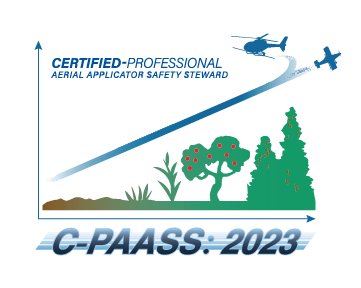ALEXANDRIA, VA – August 3, 2022 – As the agricultural aviation industry moves from its first century into its second, it faces a strong and increasing demand for fast and effective agricultural input services. It also faces challenges from additional regulations, public input, rising insurance costs, stiffer pesticide label language and competition from technological advances in other facets of agriculture. To meet these challenges, the National Agricultural Aviation Association (NAAA) is launching its Certified-Professional Aerial Applicator Safety Steward (C-PAASS) program in 2023.
C-PAASS will enable aerial applicators to augment their advancement of safety and application accuracy while also demonstrating their professional nature to their customers, regulators and the public. Requirements for certification will ensure C-PAASS members are taking part in the best available educational opportunities for agricultural aviation.
C-PAASS is by no means a requirement; however, this voluntary program will allow those aerial applicators who strive to constantly educate themselves to better their safety and applications to be recognized for their efforts. A recent NAAA survey revealed that 72% of NAAA members are interested in obtaining professional aerial application certification.
There will be four requirements for an ag pilot to earn their C-PAASS designation during the program’s 2023 launch year, with additional requirements forthcoming in subsequent years. The 2023 requirements will be as follows:
- Annual Membership in NAAA (2023).
- Annual Membership in a state or regional agricultural aviation association (2023).
- Annual PAASS (Professional Aerial Applicators’ Support System) attendance (three out of the past three years: 2022-2023 season, 2021-2022 season, 2020-2021 season).
- Biennial Operation S.A.F.E. (Self-regulating Application and Flight Efficiency) participation (one out of the last two years,or both: 2022 and/or 2023).
These initial certification requirements are based on education and professional opportunities already available to all ag aviators. The PAASS Program, from the National Agricultural Aviation Research and Education Foundation (NAAREF), has a proven record of reducing accidents and drift incidents. Five years after it debuted, the industry saw a 26% drop in drift incidents from drift surveys collected by state pesticide enforcement agencies. Since the first PAASS season in 1998-1999, the ag aviation accident rate (number of accidents per 100,000 hours flown) has dropped by nearly 26%, and the fatal accident rate has dropped by 10%.
This marked reduction in accidents and drift occurrences happened with fewer than half, or 47%, of the agricultural aviation operators and pilots in the U.S. attending the PAASS Program. (There are 3,400 ag pilots in the U.S.; 1,593 attended PAASS before the 2020 season.)
Of the 333 accidents that occurred between 2014 and 2020:
- 117, or 35%, were from pilots that had not attended PAASS in the prior five years.
- 52, or 15.6%, were from pilots that had attended PAASS once in the prior five years.
- 41, or 12.3%, were from pilots that had attended PAASS twice in the prior five years.
- 39, or 11.7%, were from pilots that attended PAASS three times in the prior five years.
- 37, or 11.1%, were from pilots that attended PAASS four times in the prior five years.
- 47, or 14.1%, were from pilots that attended PAASS five times in the prior five years.
“All these stats are a way to say that continuing education works,” NAAA CEO Andrew Moore said. “Continuing education makes you more professional. Professionalism makes you safer in the cockpit. C-PAASS is being launched as the next phase in aerial application professionalism, with a goal of increasing participation in our existing programs and expanding that participation to new education opportunities to come.”
Operation S.A.F.E. fly-in clinics offer aerial applicators a chance to verify the accuracy of their aircraft to ensure they are making precise applications that meet the demand of growers as well as protect the environment and the public.
Membership in NAAA offers numerous educational and other professional development opportunities, including markedly discounted education sessions at the Ag Aviation Expo, online NAAREF safety and education videos, Fly Safe messages, and a weekly eNewsletter. State and regional associations offer their own education opportunities. Both NAAA and state and regional associations offer leadership development opportunities and roles to help guide the industry.
In 2024, an online learning management system (LMS) will become part of C-PAASS. LMS content will be based on previous PAASS modules and sessions offered at NAAA’s annual Ag Aviation Expo. A wide variety of topics will eventually be included in the LMS, including those covered in 14 CFR Part 137 knowledge and skills and those on how to properly set up agricultural aircraft to make on-target applications. Participants will be tested on the presented material to ensure learning retention.
C-PAASS certification will be on a calendar year basis. To remain certified, C-PAASS criteria will need to be renewed annually. There will be an initial annual cost of $100 for certification in 2023.
C-PAASS certification is offered solely to individual ag pilots. That means both operator and non-operator ag pilots, can become certified. The operating company will not be certified but could advertise that all of its pilots are certified.
C-PAASS certified aerial applicators can use their certification status to inform regulatory officials and insurance agents and market to their customers that they have undergone additional training and development to best ensure that they can provide high-quality service. Ultimately, the goal is for C-PAASS certified aerial applicators to receive additional benefits for being certified. Such benefits could possibly include insurance discounts and more flexibility pertaining to pesticide label language. For instance, some labels already require Operation S.A.F.E. participation to apply the product aerially. It’s possible in the future C-PAASS certified aerial applicators may be able to apply at lower spray application rates (GPA) or with reduced wind-directional buffer zone distances.
For more information about the Certified-Professional Aerial Applicator Safety Steward (C-PAASS) program, visit AgAviation.org/cpaass.








